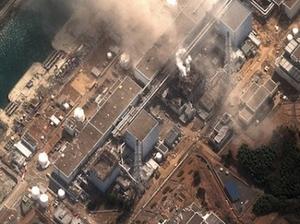Japan's nuclear crisis increasingly dire
Japan’s ongoing nuclear saga took a decided turn for the worse on Tuesday when a third explosion at a nuclear reactor may have cracked the containment unit protecting it, causing large amounts of radiation to leak out; the government requested assistance from the IAEA on Tuesday and teams were dispatched to help monitor radiation and human health; citizens within a thirteen mile radius of the Fukushima Daiichi power plant were evacuated and 140,000 residents within a twenty mile radius have been advised to stay indoors; officials also established a twenty mile no-fly zone around the power plant; officials in Tokyo reported that radiation levels were ten times their normal levels; experts say that these increased exposure levels do not pose an immediate threat to people, but the long-term effect remains unknown; the Tokyo Electric Power Company is considering using helicopters to pour cold water on top of overheating rooftops covering spent fuel rods; a small crew of fifty technicians at the badly damaged power plant is bravely fighting through high radiation levels and fires to contain the three reactors

Post-event image of Fukushima Daiichi plant // Source: globalvoicesonline.org
Japan’s ongoing nuclear saga took a decided turn for the worse on Tuesday when a third explosion at a nuclear reactor may have cracked the containment unit protecting it, causing large amounts of radiation to leak out.
The explosion occurred at the Fukushima Daiichi nuclear power plant, which has already suffered from two explosions.
A small crew of fifty technicians at the badly damaged power plant is bravely fighting through high radiation levels and fires to contain the three reactors. The reactors have suffered a partial meltdown and crews are racing to prevent a full meltdown occurring and to stop spent uranium fuel rods from bursting into flames.
The International Atomic Energy Agency (IAEA) issued a statement expressing their concern that the latest explosion may have damaged the reactor’s containment unit.
“After explosions at both Units 1 and 3, the primary containment vessels of both Units are reported to be intact. However, the explosion that occurred at 04:25 UTC on 14 March at the Fukushima Daiichi Unit 2 may have affected the integrity of its primary containment vessel. All three explosions were due to an accumulation of hydrogen gas,” the IAEA statement read.
Citizens within a thirteen mile radius of the Fukushima Daiichi power plant were evacuated and 140,000 residents within a twenty mile radius have been advised to stay indoors.
Iodine tablets have also been distributed to evacuation centers, but no decision has been made on whether to begin administering them.
The Japanese government requested assistance from IAEA on Tuesday and teams were dispatched to help monitor radiation and human health.
IAEA notes that radiation levels decreased after an initial spike from the recent blast.
Officials in Tokyo, roughly 150 miles south of the plant, reported that radiation levels were ten times their normal levels.
Experts say that these increased exposure levels do not pose an immediate threat to people, but the long-term effect remains unknown.
Lee Tin-Lap, a toxicologist at the Chinese University of Hong Kong, says, “You are still breathing this into your lungs, and there is passive absorption in the skin, eyes and mouth and we really do not know what long-term impact that would have.”
Wind has been sending the radioactive debris out to the Pacific Ocean, rather than towards other Japanese cities.
The Tokyo Electric Power Company, which operates the reactors, said that it is considering using helicopters to pour cold water on top of overheating rooftops covering spent fuel rods.
A company spokesman said, “The only ideas we have right now are using a helicopter to spray water from above, or inject water from below.”
“We believe action must be taken by tomorrow or the day after,” they added.
Early Tuesday morning hydrogen gas bubbling up from chemical reactions caused by overheating spent fuel rods at reactor no. 4 generated a powerful blast that opened a twenty-six foot wide hole in the outer building.
After a separate explosion at reactor no. 2, which ruptured the inner containment unit, an estimated 750 workers were evacuated. Fifty workers stayed behind to keep the reactors from overheating.
The explosion resulted in a massive surge of radiation that was 800 times greater than the recommended hourly exposure limit in Japan.
In a somber address to the nation, Japanese Prime Minister Naoto Kan said, “The possibility of further radioactive leakage is heightening.”
“We are making every effort to prevent the leak from spreading. I know that people are very worried but I would like to ask you to act calmly.”
